SECOND INTIFADA

Poster glorifying suicide
bomber found in Jenin The Second Intifada began in October 2000 after Israel Prime Minister Ariel Sharon visited the Temple Mount (See Below). As of October 2004, 3,070 Palestinians and 940 Israelis had been killed in the uprising. As of November 2002, almost 2000 Palestinian, including around 250 children, were dead and more than 40,000 were wounded and 650 Israelis, including 75 children, were dead and 5,000 were wounded. The numbers are widely disputed and the Palestinians generally insist there were more casualties than those mentioned above. Counting Muslim dead is always tricky because customs dictates that dead be buried quickly.
The Second Intifada is known to Palestinians and Arabs as the Aqsa Intifada because the uprising began at Aqsa mosque on the Temple Mount. It was supported strongly by Palestinians who were angry with Sharon, tired of being mocked and humiliated by the Israelis and frustrated that the 1993 Oslo peace accord had delivered few tangible results. According to surveys, 70 percent of Palestinians backed the Second Intifada and an equal number felt that suicide bombs were justifiable.
But the Intifada brought Palestinians few benefits other than sympathy from the international community and pride for fighting back against the Israelis. Intifada violence stirred up animosity between Palestinians and Israelis and led to the loss of 6,000 Palestinian homes, 100 public buildings and the uprooting of 25,000 trees in Palestinian territories. The number of Israeli that died was equivalent to the number that die every year in car accidents.
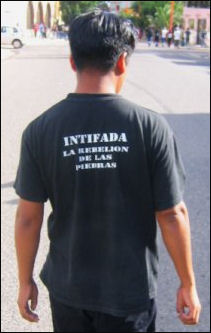
On September 29, 2000, accompanied by hundreds of police, Sharon and a group of legislators visited the Temple Mount, the most disputed piece of land in Israel. On it lies the Dome of the Rock, Islam's third holiest shrine, and the al-Aqsa Mosque. Next to it is the Western Wall, the Jew’s holiest place, which was is part of the great Jewish Temple built by Herod the Great in 74 B.C. on the Temple Mount.
Sharon made the visit to boost his political standing and reassert Israel’s right to the land. He later said, “A Jew in Israel has the right to visit the Temple Mount. The Temple Mount is still in our hands.” The Palestinians viewed the visit as a provocation. Afterwards, a long period of violence, the Second Intifada , began. Many Israelis believe the Palestinians were planning violence and were waiting fo an excuse. Sharon said, “My visit to the Temple Mount served only as a poor excuse to launch this premeditated, orchestrated campaign.”
The Palestinian were less united by Arab nationalism as was the case in the past and stirred up by Islamic fundamentalism. As the clashes became more intense, many Palestinians looked to Hamas and Muslim extremists for leadership, regarding Arafat and the Oslo Peace accord as passe. Demonstrations were held all over the Muslim world condemning Israel and showing support for the Palestinians.
Fighting in the Second Intifada
Violence in the Second Intifada included targeted assassinations, late night commando raids, bus bombings, bar mitzvah shootings, street riots, town sieges, bicycle bombers, clashes at holy sites, bulldozers leveling neighborhoods, car bombs, sniper fire fights, house raids, human shields, mortar attacks on settlements and farms. In the day Israeli soldiers often battled teenage rioters. At night they fought Palestinian soldiers.
Much of the violence was cyclical, with the Palestinians retaliating against perceived injustices, humiliations, bullying and provocations by the Israelis, and the Israelis retaliating against suicide bomber attacks. Many of the Israelis were killed in suicide bomb attacks and strikes against Israeli forces. Most of the Palestinians were killed in day to day fighting.
Children and teenagers hurled rocks and used slingshots and Israeli soldiers responded with tear gas, percussion grenades and rubber bullets as in the first Intifada . But this time in Palestinian territories, Palestinian snipers and gunmen took up positions in houses in populated areas and fired bullets and mortars and launched grenades at Jewish settlers and Israeli military targets while the Israelis responded with rocket and machine gun fire, helicopter gunship attacks, tank maneuvers, missile launched from planes and helicopters and precision air bombings.
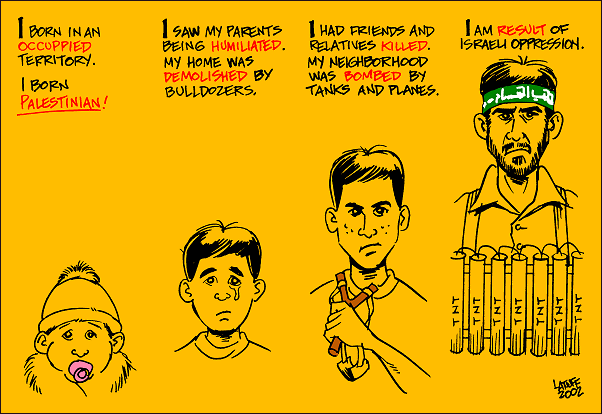
In October 2000 the death of 12-year-old Mohammed al-Durra was captured on video and shown all over the world on television. Al-Durra and his father got caught in crossfire between Palestinian militiamen and Israeli soldiers at an entrance to a controversial Jewish settlement in Gaza. As the boy sat huddled and screaming next to his father he was hit in the abdomen by an Israeli bullet. By the time rescuers arrived an hour later he was dead.
Al Durra became a high profile martyr. His father said he and his son were on their way to check out a used car and got caught in the crossfire. Other say that al-Durra had been throwing stones and his father had come to get him. The place where they sought refuge unfortunately for them was right in front of a place where Palestinian militia men were firing on the Israelis.
Also in October 2000, in Ramallah, a mob killed two Israeli reserve officers, who had taken a wrong turned and ended up in the wrong place. One of them was thrown from a window of police station onto the street. Israeli forces responded by bombing the police station. Palestinians covered themselves with blood from people killed at the police station.
Palestinian Fighters and Children in the Second Intifada
Fighters with Hamas, Islamic Jihad and Arafat’s al-Aqsa Martr’s brigade, Tanzim militia and Force 17, battled Israeli forces in the West Bank and Gaza Strip. Hezbollah guerillas launched attacks on Israeli positions from southern Lebanon. Many of the Palestinian snipers and militiamen were trained fighters. Some had been trained at camps in Lebanon and Afghanistan. One fighter told Newsweek, “It is better to die with dignity than live as a slave.”
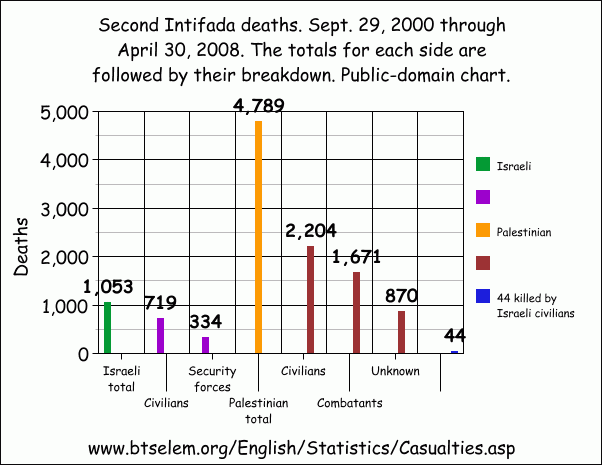
Intifada deaths
Many of the street fighters were adolescents from the refuge camps in the West Bank and the Gaza Strip. Children who were seven and eight participated in the rock throwing and violence and children as young as nine were shot and killed by Israeli bullets. Some wore Muslim green headbands inscribed with words “There is no God but Allah” and told journalist they wanted to become martyrs and “bring honor to their families.” The Israeli condemned the Palestinians for letting the children fight when they should have been in school.
Many of child and teenage fighters were bused in and out on dump trucks owned by Palestinian security forces. These youths often showed little rage and went through the motions as of it were a duty. Their rocks and Molotov cocktails often landed far from their intended targets. When asked why they were fighting they often repeated anti-Jewish and anti-Israeli slogans they heard on television. It was not uncommon for a mother to show up at the front and spot her child and haul him away with a firm grip on his arm.
When youths were killed they were given the same martyr treatment as suicide bombers. Sometimes hours after their deaths their faces are slapped on posters with the Dome of the Rock in the background and plastered on walls throughout the West Bank and Gaza Strip.
Qassam Rockets, Collaborators and Suicide Bomb Attacks Against Israeli Military Targets

Qassam damage in
Sderot Israel Qassam (Kassam) rockets were the weapon of choice for Palestinian rocket attacks. They are crude and have a range of about 10 kilometers and are wildly inaccurate but deadly when they strike a target. Manufactured in garages and apartments, they are three to six feet long and packed with between four and 10 kilograms of explosives. They are launched from collapsible tripods. Militants also picked off Israelis randomly in drive-by shootings. In one case they killed a jogger then publically apologized when it was revealed that the jogger was an Israeli Arab.
In January 2004 a female Hamas member, feigning a limp, blew herself up inside a worker’s checkpoint at the Erez border crossing in the Gaza Strip. Four members of the Israeli security forces were killed.
Some of harshest Palestinian violence was directed at Palestinian informers who collaborated with the Israelis. Dozens of collaborators were killed without being arrested or put on trial. Some were shot dead and hung from lamp posts or publically executed by firing squads in public squares. Others were shot suddenly as they walked down the street or blown up in booby-trapped cars. The families of the collaborators were shamed and ostracized.
Israel’s Response to the Second Intifada
Israel responded to the Second Intifada by closing the borders between Israeli and the West Bank and Gaza Strip. Tens of thousands of Palestinian were unable to work in Israel and families had to beg for food from relief agencies. Aid agencies had difficulty getting food and medical supplies into te Gaza Strip.
Blockades were set up around Bethlehem, Ramallah, Nablus, Tulkarm and Qalqiliya in the Palestinian territories. Curfews were established in Hebron that closed schools, markets, access roads and even public baths. In Israel, Arabs were subject to “administrative detention,” a euphemism for jailing people without a trial. As of February 2005, Israel held 8,000 Palestinian prisoners.
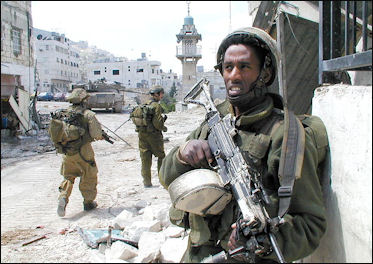
Israel Defense Forces in Nablus Israel has used F-16 jets, missiles and helicopter gunships in attacks on Palestinians. Israeli forces positioned themselves outside Jewish settlements to protect settlers, guarded border posts, checked IDs, enforced shoot-to-kill curfews, strip searched suspects and required them to dismantle their vehicles to prove they had no weapons, dug trenches around Palestinian towns and filled them with barbed wire, set up spot highway checkpoints presumably to keep terrorists from entering Israel and raided houses of suspects in the middle of the night. They also entered West Bank and Gaza towns to carry out retaliatory raids and make moves to arrest terrorist and Intifada leaders and fighters, and to seek out weapons caches and bombmaking labs. Sharon said, “it’s war going on here. You have to take your enemy out of balance by presenting him daily with new problems. He should be defending himself rather that attacking us.”
Soldiers often fired rubber-coated bullets. When shot from a distance these bullets leave a painful welt and rarely cause serious injuries but when they are fired from short range they can be quite deadly, piercing the skull and leaving behind a hole that oozes brain matter. Israel security forces also fired pellets made of various materials that are not as deadly as bullets but can cause death or serious injuries.
In armed riots, soldiers were cleared to shot at ringleaders or anyone with a weapon. They also are allowed to shoot at vehicles with gun men in them. Wind, stress and aiming errors sometimes caused sniper bullets to strike unarmed protesters. Stray bullets sometimes hit bystanders. Tanks plow through neighborhoods and occasionally blasted away at targets. Helicopter gun ships fired missiles at cars carrying militants. They often got their targets but sometimes they missed. A number of civilian, including children, were killed in such attacks.
Israeli Checkpoints During the Second Intifada

Checkpoint near Abu Dis Israelis set up dozens of roadblocks to keep militants from reaching Israel and to crack down on the movement of weapons. Israeli checkpoints were perhaps the most obvious symbol of the Israeli occupation. The checkpoints were everywhere. They were set up on all the major roads and often had traffic lights and were guarded by heavily armed soldiers, who often chatted and joked and took their time checking cars and waving them through, allowing the cars to pile up into long lines.
People were prevented by roadblocks from taking the most direct routes from place to place and forced to take long detours. Some Palestinians got around the checkpoints by walking on paths that went around them. Others took taxis to the checkpoints walk across and got a taxi on the other side to avoid vehicle searches. Traveling 10 miles this way sometimes required three taxi changes. Palestinians that sold snacks and drinks at the checkpoints did good business.
In many cases, vehicles and their occupants were rigorously searched at the Israeli checkpoints, creating delays of several hours, resulting in great disruptions to commerce and making it difficult for Palestinians to go to work and visit relatives, reach funerals or other family events, seek medical help and reach schools even in nearby places.
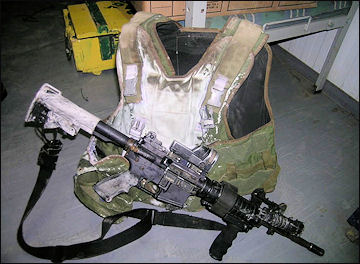
Palestinian woman sprays
acid at IDF soldier A drive of 25 miles between Ramallah and Nablus could take five hours. Palestinians who lived a 20 minute drive from relatives where unable to see them because the hassles are just too great.. Even ambulances and pregnant women were searched. Doctors needed three hours to travel 11 miles from their homes to the hospitals where they work. Women gave birth at the checkpoints because they haven’t been able to reach medical help in time. A Palestinian with his dead two-year-old daughter in his arms was held up at checkpoint as he tried to get his daughter back home to give her a proper burial.
Tensions ran high at the checkpoints. Israeli soldiers were jittery and worried about attacks and suicide bombers. Palestinians were subjected to humiliating searches and delays. Restrictions on the Palestinians were popular with Israelis because they made the Israelis feel safe. After some Palestinian attacks and suicide bombings entire areas inside the Palestinian territories — including the entre West Bank and Gaza Strip — were cordoned off.
Palestinians claim they had had their faces smashed by rocks by Israeli soldiers and were shot at as they attempted to take shortcuts around checkpoints. Sometimes Palestinians were shot and killed for arguing with Israeli soldiers at checkpoints. One Palestinian man told Reuters the Israelis “behaved like an occupying authority. They curse people. They force some of them to take off their clothes or to dance.” He also said the Israeli soldiers “play with people’s nerves” by quickly changing the traffic lights so only a few cars have time pass through. “If you move then you are killed for violating the orders to stop as they say.”
Destroying Palestinian Houses

American Rachel Corrie
killed March 2003 trying
to stop Israeli bulldozers Much of the violence was in Gaza where militants from Hamas and Islamic Jihad were hiding and militants fired rockets and mortars into Israel. Gaza was also where Israeli troops carried out retaliations for suicide bombs and rocket attacks and launched brutal raids and fired missiles from helicopters and war planes, . The Israelis raided refugee camps thought to be harboring militants; fired missiles into Gaza City, targeting militant leaders.
Palestinians suspected of having connections to terrorists or the Intifada were evicted from their houses and stood by helplessly watching as their houses were bulldozed down. Bulldozing houses in neighborhoods where suspected terrorists lived was favorite tactic of retaliation. The tactic was also used on Arab homes that had been built without permits, a policy that many Palestinians found particularly unfair in light of the fact that thousands of homes were built on Palestinian land in Jewish settlements.
The bulldozers often showed up in the middle of the night and occupants watched in their pajamas as their houses were torn down. The owners were usually given a warning to vacate or get trapped in the rubble. One woman whose houses was destroyed told Reuters, “We heard the tanks rolling, and we saw the bulldozer from the balcony. The first thing I did was to carry my sleeping children and rush out of the house.” A Palestinian man told the U.S. News and World Report, “The Israelis believe in collective punishment. If one Palestinian does something wrong, then all Palestinians have to pay for it.”
Israelis destroyed the house of a teenage suicide bomber. They also destroyed houses that served as cover for attacks on Israeli soldiers and destroyed thousand of acres of crops. Sometimes people inside destroyed houses were killed. In February 2003, the stepmother of a Palestinian militant was killed when her and the militant’s house was destroyed while she was still inside.
Impact of Israeli Occupation During the Second Intifada
After the harsh crackdowns by Israelis in the Second Intifada even moderate Palestinians began to fill with hatred against the Israelis. One woman in Ramallah told Newsweek, “The only solution — it pains me to say — is more violence than exist now. When Israelis begin to realize that they have no security, that their people are dying for nothing, then they will begin to feel our suffering.”
One man told the Washington Post, “I used to be a calm person. Now when the kids are noisy, I will yell at them, I even beat them. People have noticed. They ask me what’s wrong, have you gone crazy? It’s the psychological pressure and the military pressure.” Another said, “We are really bored. I’m tired of my life. I can’t do anything. I’m stuck here.”
The occupation did help to reduce the violence within Israel and according to some sources stopped 86 percent of the suicide attacks.
Terrorist Attacks in Israel in the Early 2000s
There were 112 suicide bombings, killing more than 450 Israelis, between September 2000 when Sharon visited the Temple Mount and March 2004. Hamas took responsibility for the majority of the attacks but Islamic Jihad and the Al-Aqsa Martyrs’s Brigade were also involved in quite a few. In most cases Palestinian Authority leader Yasser Arafat condemned the attacks. But many held him responsible because he didn’t do much to reign in the groups that carried out the attacks.
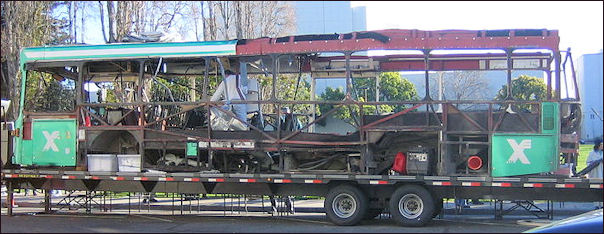
Bus 19
The attacks were serious but were much less frequent and killed less people than terrorist attacks in Iraq. Many attacks occurred on city buses in Jerusalem. Palestinian militants occasionally kidnaped foreigners but not very often and in most they were set free not long after they were captured.
In 2002, Jerusalem passed Columbo as the world suicide bomber capital of the world,. As of 2004, the city had been hit by 37 suicide bomb attacks, which had killed 242 people and injured 1,631 others. Not long after that Jerusalem was surpassed by Baghdad.
Palestinian militants tried on several occasions to stage spectacular attacks along the lines of September 11th. An attack on fuel depot in a crowded area of Tel Aviv in May 2002 didn’t kill anyone. A tanker truck was blown up by remote control, nearly setting off an explosion at the depot. A plot to blow up a skyscraper in Tel Aviv using a car packed with a ton of explosives parked in a garage below the building was also foiled..
All during the Second Intifada period there were suicide attacks throughout Israel in which few people or no one was killed or injured. Even so these attacks and attempted attacked still caused terror among the populace. In some cases the bombers chickened out at the last minute or were caught before they had a chance to blow themselves up. By one estimate Israelis were able to prevent 86 percent of the suicide bombings from taking place.

Terrorist Attacks in Israel in the Early 2001
On February 14, 2001, a Palestinian bus driver killed eight Israelis and injured 18 others with his bus. Regarded as an exemplary employee, he became angry after he was prevented from working because the border between Gaza and Israel was closed. When he returned to work he stepped on the gas pedal of his bus and plowed it into a crowd of soldiers waiting at a junction near Tel Aviv. Bodies were everywhere. Some had their heads split open. Seven of the dead were soldiers. Five were women. It was the deadliest attack on Israelis since the Second Intifada began and the deadliest attack in Israelis in four years.
There were nine bombings and suicide bombings in March, April and May 2001. The causalities included about a half dozen suicide bombers, a dozen Israelis and scores of injured. There were other Israeli deaths as well. In March, a 10-month-old baby was killed by Palestinian sniper fire in a settlement near Hebron. In May, two Jewish 14-year-olds from a West Bank settlement were smashed beyond recognition with rocks in a cave and their blood was smeared on the walls of the cave.
During the same period dozens of Palestinians, including a four-month-old baby girl, were killed in retaliatory attacks by Israelis. In the middle of this wave of terrorism, on April 17, Israeli forces seized a piece of Palestinian-controlled territory in the Gaza Strip. They retreated after criticism from U.S. Secretary of State of Colin Powell. In late May, F-16 fighter jets were used to strike targets in Nablus.
In January 2001, a 16-year-old Israeli boy, Ofir Rahum, was killed after arranging to meet a Palestinian woman, Amneh Mona, he met on a Internet chatline. After flirting for several months they arranged to meet. Muna wrote: “You don’t know how much I’m waiting.” They met in West Jerusalem and took a taxi to her car. They then drove towards Ramallah, and pulled off at a designated spot, where two Fatwa gunmen were waiting and killed Rahum with a hail of bullets. Muna was arrested. She had worked before as a journalist and interviewed the families of many victims of Israeli aggression and said she wanted to get revenge.
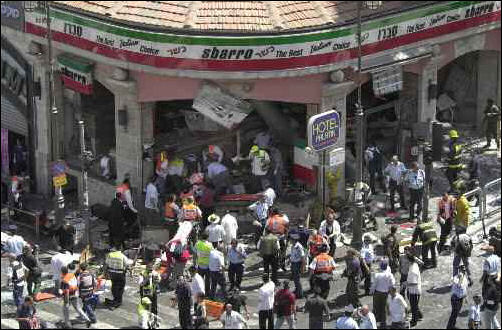
Pizza parlor after attack
On June 1, 2001, a 22-year-old Jordanian blew himself up in a line of people waiting to get into a beachside disco in Tel Aviv, killing 22 and injuring around 80. Most the dead and injured were teenagers and people in their 20s, waiting to get into the club. The bomber had hepatitis B and is believed to have infected some of the wounded with the disease.
Terrorist Attacks in Israel in Mid and Late 2001
On August 9, 2001, a Palestinian suicide bomber blew himself up in a crowded pizzeria in downtown Jerusalem with a bomb packed with nails and hidden in a guitar case, killing 16 people — including the bomber and two Americans — and injuring 130 others. The restaurant was popular with families. Many of the dead and wounded were children and teenagers. One survivor told the Washington Post, “There were wounded people, blood everywhere. The whole restaurant was in pieces...We saw lots of blood. I saw a woman on the ground, she was totally shredded.” Hamas claimed responsibility for the attack. In October 2005, a Palestinian woman was sentenced to 320 years in prison for her role in the pizzeria suicide bombing. She escorted the bomber to the packed Sharro restaurant.
In August 2001, a Palestinian gunman unloaded a clip of bullets from an automatic rifle outside a compound in Tel Aviv that houses Israel’s defense ministry and army headquarters. No one died but the point was made that even the army brass was not safe from Palestinian attacks. See Israeli Attacks Against Terrorists
In late November, 2001 five Palestinian children were killed by a bomb planted by Israeli forces near Khan Younis refugee camp in Gaza. Israel first asserted the children died playing with an unexploded tank shell. Later it was revealed they were killed by a bomb targeting gunmen who fired at Israeli army posts. There were a number of other reports around the same time of children getting killed in Gaza.
On December 1 and 2, 2001, 27 people were killed in three suicide bombings in Israel. Two suicide bomber detonated nailed-studded explosives in a busy pedestrian mall in Jerusalem, killing 17 bystanders and wounding 150, most of them young people. Twelve hours later, 10 people were killed and 40 were wounded when a bomb exploded on a bus in Haifa. A witness to the Jerusalem bombings told AP, “A lot people were crying, falling and there was the smell of burned hair.” The bombings were linked to Hamas. Earlier in the week seven other Israelis had been killed in other incidents.

Posters of Martyrs (suicide bombers) in classroom in Tul Karem
Terrorist Attacks in Israel in 2002
Bruce Hoffman wrote in The Atlantic Monthly: By any measure 2002 was an astonishing year for Israel in terms of suicide bombings. An average of five attacks a month were made, nearly double the number during the first fifteen months of the second intifada — and that number was itself more than ten times the monthly average since 1993. Indeed, according to a database maintained by the National Security Studies Center, at Haifa University, there were nearly as many suicide attacks in Israel in 2002 (fifty-nine) as there had been in the previous eight years combined (sixty-two). In Jerusalem alone there were nine suicide attacks during the first four months of 2002, killing thirty-three and injuring 464. "It was horrendous," a young professional woman living in the city told me. "No one went out for coffee. No one went out to restaurants. We went as a group of people to one another's houses only." [Source: Bruce Hoffman, The Atlantic Monthly, June 2003]
In January 2002, a ship loaded with 50 tons of arms was intercepted in the Red Sea by the Israeli Navy. The arms were shipped out of Iran by Hezbollah to support Yasir Arafat’s Fatah faction. It is widely believed that Arafat knew about the shipments even though he denied he did. The Israeli were not pleased.
On April 12, 2002, after Operation Defensive Wall, a major Israeli offensive into Palestinian territory, a bombing at the Mahane Yehuda market in Jerusalem during the middle of the pre-Sabbath shopping rush left six dead and 80 wounded. The bomber was a 20-year-old woman from a small town near Bethlehem. She planned to enter the market but found it was heavily guards so she headed instead to a crowded bus stop. After the bomb went off her head was seen rolling down the street. On April 10, a suicide bomber blew himself up on a bus in Haifa and left eight dead.
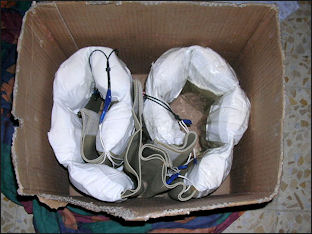
Explosive belts found on Tanzim operatives On May 8, a suicide bomber blew himself up in a third-story pool hall in the Tel Aviv suburb of Rishon Letzion, killing 15 Israelis. The bomb was inside a suitcase. It was powerful enough to blow the walls out of the hall and send bodies flying into the parking lot. It was the 20th suicide bombing so far in 2002.
On June 5, a 16-year-old suicide bomber blew himself up in a car rammed into a bus at Megiddo Junction in northern Israel near Afula, killing 17 Israelis. Most of the dead were soldiers on their way back to their bases. The car was packed with 220 pounds of explosives. Islamic Jihad claimed responsibility. On June 18, a suicide bomber blew himself up on a bus loaded with schoolchildren, killing 19 Israelis and wounding 55, in the deadliest attack in Jerusalem in six years. The blast, caused by 22 pounds detonated after the bomber stepped on the bus, could be heard three miles away. Israeli intelligence had been alerted that a bombing was going to take place and were informed of the identity of the bomber. More than a thousand men were looking for him but couldn’t find him in time. Hamas claimed responsibility,. The next day police thwarted a bomber who blew himself up 60 yards short of his target. The day after that five Jewish settlers, including a mother and her three children, were shot and killed by Palestinian infiltrators.
On July 17, Palestinian gunmen ambushed a bullet-proof, armored-plated bus filled with Jewish settlers in the West Bank near Emmanuel, killing 7 Israelis and wounding 20. As the bus approached a Jewish settlement an explosive hidden in the road was set off and the gunmen dressed in Israeli military uniforms opened fire on the passengers as they tried to flee. The gunmen escaped. The attack took place just as peace negotiations were set to resume. Emmanuel is between Nablus and Qalqilya. The Al-Aqsa martyrs Brigades took responsibility. On July 31, a powerful bomb hidden in a bag was set off in the cafeteria at Hebrew University, killing nine, including five Americans, and wounding more than 80. Hebrew University is a place where Israelis and Arabs mingle, take classes and eat together. Arab students were among the wounded. Hamas claimed responsibility, claiming it was retaliating for the deaths of its leaders.
In October 2002, a car bomb in northern Israel at Karkur Junction, near Hadera, turned a bus into a raging inferno, killing 14 people and injuring dozens. The car with the bomb pulled up next to the bus, which had stopped at a highway station during the afternoon rush hour. On November 15, 2002, 12 Israeli settlers and soldiers were killed in a carefully orchestrated ambush in Hebron. The Israelis had just emerged from the Tomb of the Patriarchs and were walking along Worshipers’ Lane when grenades were hurled and bullets were fired at them by Palestinian militants. Israeli soldiers that rushed to scene were also caught in the ambush. Gun battles raged for more than 90 minutes. Five Palestinians were killed in retaliatory raids on neighborhoods near the Jewish settlement in Hebron. Also in November, a hijack attempt of El Al airlines flight to Istanbul with 170 passengers. was foiled
Child and Female Suicide Bombers in Israel in Early 2002
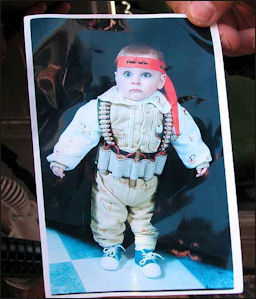
Picture found in Hebron On January 27, 2002, Wafa Idrees, the first female bomber to strike inside Israel, killed one person, an elderly Jewish man, in an attack. Compared with Joan of Arc in the Palestinian territories, she was an ambulance worker, reportedly motivated by the carnage she witnessed at the hands of the Israelis. After her death. Her face was all over the territories: on widely circulated posters, on television, and in the international press. A week or so earlier a member of Arafat’s Fatah group shot up the bat mitzvah of a 12-year-old girl, killing six.
On March 27, 2002, a Hamas suicide bomber disguised with a wig as a woman entered the Park Hotel in Netanya and blew himself up in the middle of 250 Israelis who just sat down for Passover dinner. A total of 28 people were killed and 150 were injured. Television images of the bombing on television showed splattered blood and bodies among prayer books and place settings. The attack, which became known as the Passover massacre, was the deadliest of the Second Intifada.
Two days later a 17-year-old Palestinian girl scheduled to be married the next summer, blew herself up at a Jerusalem supermarket, killing two bystanders and injuring 19 others. The next day a suicide bomber, belonging to a militia with links to Arafat’s Fatah movement, blew himself up in Tel Aviv, injured 32 people, the day after that a Hamas suicide bomber blew himself up in Haifa, killing 14 people.
Not long after this three 14-year-old boys, who were regarded as the smartest kids in their 8th grade class, made a pipe bomb armed themselves with knives and tried to tunnel under a fence of Gaza Strip Jewish settlement. They were spotted by Israeli guards and shot and killed. Afterwards there was widespread condemnation of suicide bombing as tactic. Even Hamas came out and said that children should not become suicide bombers.
Israeli Retaliations in 2001 and 2002
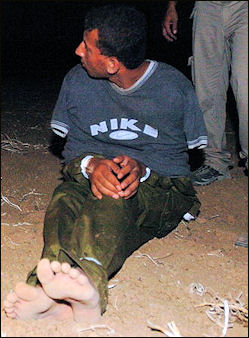
Suicide bomber stopped in Gaza After the attacks in December 2001 Israel retaliated with helicopter gunship and F-16 attacks against Palestinian targets in the West Bank and Gaza Strip. Police buildings in Jenin were destroyed. The runway of the airport in Gaza was ripped up with bulldozers. Twenty three Palestinians were killed in the first week of retaliations alone. More were injured. Helicopter gunships attacked Arafat’s headquarters in Ramallah. Three missiles hit just a few meters from his office. He was there but wasn’t injured. Three of his helicopters were badly damaged and he became a virtual prisoner in his office. He remained there for weeks. In mid December, Israel severed its ties with the Palestinian government.
The year 2002 started with Arafat essentially under house arrest in his offices in Ramallah with Israeli Merkava tanks positioned only 60 meters away. In retaliation for Palestinian bombing attacks and sniper shootings — one of which left 10 people dead, including Israeli soldiers, at a West Bank checkpoint — in early March, 2002 the Israelis razed Arafat’s Gaza headquarters and conducted raids throughout the Palestinian territories.
In retaliation for the June 5, 2002 attack, Sharon ordered bulldozers to level buildings in Arafat’s compound in Ramallah. After the June 18 attack Sharon visited the bomb site and sent in helicopters and bulldozers and reoccupied Jenin, Hebron, Bethlehem, Ramallah, Nablus and other places and imposed a curfew that affected 600,000 people In late July in the southern Gaza Strip Israeli helicopter gunships fire missiles into two taxicabs, killing six people including two high ranking Hamas officials. The main target was Yasser Razek, head of the Hamas military wing in Rafah. Also in late July, another Hamas leader, Salah Shehada, was killed along with his wife and three daughters with a 2000-pound missile fired from an Israeli F-16 on his house in a crowded Gaza neighborhood. Ten others, including five children, were killed and more than 145 people were reported injured by the blast. The spiritual leader of Hamas, Sheik Ahmen Yassin, was placed under house arrest. On August 30, a helicopter attack on a car in the West Bank killed a Palestinian militant, two teenagers and two children. The Palestinian was a leader in the al-Aqsa Martyr’s Brigades. The two teenagers were in the car. The children were playing and were killed by a missile that missed its target. In early September tanks rolled into the Gaza Strip, suspected militants were arrested and a large bomb-making laboratory was shut down. Later that month, after a suicide bomb on a Tel Aviv bus killed five people, bulldozers knocked down buildings in Arafat’s Ramallah compound.
In November, Israeli tanks and soldiers moved into Hebron and destroyed the homes of gunmen involved in an attack on settlers. In Gaza, helicopter gunships fired missiles at targets and tanks took up positions in the outskirts of town. In one raid in December, Israelis killed 10 Palestinians, eight of them unarmed civilians.. Israeli troops entered Bethlehem, then withdrew as a goodwill gesture around Christmas time and then re-entered the city, killing seven Palestinians in the process. Arafat was barred from visiting Bethlehem by the Israelis.
Decline of Terrorist Attacks in Israel in Late 2002 and 2003

vehicle of Palestinian suicide bomber Bruce Hoffman wrote in The Atlantic Monthly: Twelve Israelis were killed in terrorist attacks in January, twenty-six in February, 108 in March, and forty-one in April. The population of the United States is roughly forty-seven times that of Israel, meaning that the American equivalent of the March figure would have exceeded 5,000 — another 9/11, but with more than 2,000 additional deaths. [Source: Bruce Hoffman, The Atlantic Monthly, June 2003]
“After April of 2002, however, a period of relative quiet settled over Israel. The number of suicide attacks, according to the National Security Studies Center, declined from sixteen in March to six in April, six in May, five in June, and six in July before falling still further to two in August and similarly small numbers for the remainder of the year. "We wouldn't want it to be perceived [by the Israeli population] that we have no military answers," a senior IDF planner told me. The military answer was Operation Defensive Shield, which began in March and involved both the IDF's huge deployment of personnel to the West Bank and its continuing presence in all the major Palestinian population centers that Israel regards as wellsprings of the suicide campaign. This presence has involved aggressive military operations to pre-empt suicide bombing, along with curfews and other restrictions on the movement of residents.
In 2003 and 2004 the number of suicide attacks decreased and the overall death toll was lower. The decease was attributed to heightened security and vigilence, but still a significant number of attacks occurred.
Terrorist Attacks in Israel in 2003

Suicide bomber in Dizengoff street On January 5, 2003 a suicide bomber blew himself up near the old central Bus Station in Tel Aviv, killing 23 people. Al Aqsa Martyr’s Brigaded and Islamic Jihad took credit and said they worked together. In March, a suicide bomber detonated his explosives on a crowded bus in Haifa, killing 15 people. In April, a suicide bomber blew himself up near the entrance of the beachfront pub Mike’s Place in Tel Aviv, killing three Israelis and injuring 45. Al Aqsa Martyr’s Brigaded and Hamas took credit and said they worked together.
In March Bruce Hoffman wrote in The Atlantic Monthly: “No one paid much attention to a young man dressed like an ultra-Orthodox Jew who was standing near some parked cars as guests left a bar mitzvah celebration at a social hall in the ultra-Orthodox Jerusalem neighborhood of Beit Yisrael. Then he blew himself up, killing nine people, eight of them children, and wounding fifty-nine. The tight-knit religious community had felt that it was protected by God, pointing to the miraculous lack of injury a year before when a booby-trapped car blew up in front of the same hall. Using a strategy al Qaeda has made familiar, the terrorists revisited the site. [Source: Bruce Hoffman, The Atlantic Monthly, June 2003]
Less than a month after the Beit Yisrael attack the suicide bombers and their leaders drove home the point that Israelis cannot feel safe anywhere by going to the one large Israeli city that had felt immune from the suspicion and antipathy prevalent elsewhere — Haifa, with its successful mixture of Jews, Christian and Muslim Arabs, and followers of the Bahai faith. The University of Haifa has long had the highest proportion of Arab students of any Israeli university. The nearby Matza restaurant, owned by Jews but run by an Israeli Arab family from Galilee, seemed to embody the unusually cordial relations that exist among the city's diverse communities. Matza was popular with Jews and Arabs alike, and the presence of its Arab staff and patrons provided a feeling of safety from attack. That feeling was shattered at two-thirty on a quiet Sunday afternoon, when a suicide bomber killed fifteen people and wounded nearly fifty.
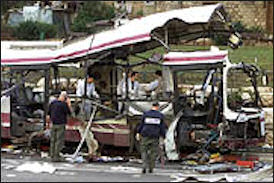
Haifa bombing In May 2003, a suicide bomber dressed in a yarmulke and Jewish prayer shawl killed seven people in a crowded bus in Jerusalem. Not long afterwards another suicide bomber detonated his explosive but managed to kill only himself. In June, a suicide bomber detonated his devise on a crowded bus in Jerusalem, killing 16 and injuring more than 100. The bomber, sent by Hamas, was dressed as an ultra-orthodox Jew. The attack was carried out to avenge the killing of a Hamas leader. The 18-year-old bomber was considered a serious student and, according to family members, studied hard for an English test on the day he blew himself up. Israel in retaliated within minutes, killing one immediately and five a few hours later.
In August 2003, a suicide bombing on a crowded bus by Hamas killed 19 and injured more than 80 in Jerusalem. The bus was packed with ultra-Orthodox Jews returning from prayers at the Western Wall. Many of the dead were children. Hamas and Islamic Jihad took credit for the attack. Two days latter the Israelis retaliated by killing Hamas leader Abu Shanab.
In September 2003, two suicide bombers killed 15 people and injured 25 others in attacks that took place within five hours of one another. One blast occurred in a Jerusalem cafe. The other was at a bus stop crowded with Israeli soldiers outside an army base near Tel Aviv. That attack splattered human remains all over the top of the five-meter-high bus stop roof. A limb hung from the roof. Hamas claimed responsibility for both attacks, seen as retaliations for a missile attack on the home of a Hamas leader. After the attack the Sharon government asserted that is was going to oust Arafat for not doing more to stop the attacks.
In December, a suicide attack at a Tel Aviv bus stop killed four. The attack was in the evening just as many Israelis were heading home for the seventh night of Hanukkah. The Popular Front for the Liberation of Palestine (PFLP) took credit for the attack.
Terrorist Attacks in 2003 and 2004 in Israel by Female Suicide Bombers
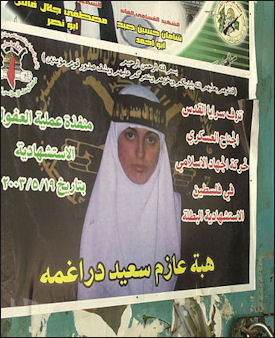
Propaganda poster glorifying
suicide bomber In May 2003, a 20-year-old female suicide bomber blew herself up near the entrance of the northern Israeli town Afula, killing herself and three Israelis. The bomber was a model student and a very devout Muslim who wore a veil even though her family discouraged her from doing so and appeared to have been at least partly motivated by the arrest of her brother by the Israelis. Al-Aqsa Martyr’s Brigades and Islamic Jihad took credit and said they worked together.
In October 2003, a female Palestinian suicide bomber blew herself up at a popular Jewish-Arab beachfront restaurant in Haifa during lunch, killing 19 — including a two-month-old infant and children aged 1,5 and 6, a newlywed couple, and four Arab Israelis — and wounding 50. An Arab waiter who worked at the restaurant told the Washington Post, “It was an awful explosion. I was on my way to kitchen and turned around. The tables, the chairs,”everything — were turned upside down. Children were killed. there was one without a head. It was a horror.” An accountant who was eating at the restaurant at the time of the blast said, “All my friends hit the ground. Two were nearby and not moving. They were bleeding from the mouth. I pushed them three or four times. They didn’t give any sign of being alive. I turned around and saw people on the floor without heads, without faces. It was something terrible.” The bombers head, with her hair in a ponytail, was found on a table.
The Haifa restaurant, Maxim’s, was owned by Israeli Arab Christians and was popular with Israeli Arabs and Jews. To outsiders the presence of Arabs would seem to make it an unlikely target but one Israeli told the New York Times that in fact the opposite was true because the bomber could enter without drawing suspicion. Islamic Jihad claimed responsibility for the attack. The bomber, Handi Jaradat, was from the West Bank town of Jenin. She had graduated from law school in Jordan. Relatives said her brother and cousin ad been killed by Israeli troops three months before. In retaliation Israel launched air strikes against an Islamic Jihad training camp in Syria. It was the first attack inside Syria in 26 years. Needless to say the Syrians were not to happy.
Female suicide bombers were able to sneak past Israeli security easier. In January 2004 another female bomber blew herself up at the Erez checkpoint at Gaza, killing three Israeli soldiers and a security guard. On the tactic of using female suicide bomber Hamas spiritual leader Sheikh Ahmed Yassin said, jihad is “an obligation of all Muslims, men and women.”
Terrorist Attacks in Israel in 2004

BeerSheva Terror
Attack memorial In January 2004, a Palestinian policeman from Bethlehem blew himself up on Jerusalem bus, 15 meters from Sharon’s residence, killing 10 Israelis and wounded 50 people. Hamas and al-Aqsa Martyr’s Brigades claimed responsibility. The bomber carried a note that said he carried out the attack to avenge the killing of eight Palestinians killed by Israeli troops in the Gaza Strip. The Israelis retaliated by staging a raid with tanks into Bethlehem.
In March 2004, two teenage suicide bombers with Hamas and al-Aqsa Martyrs Brigades blew themselves up at the Mediterranean port of Ashdod, 20 miles north of the Gaza Strip, killing 12 people (themselves and 10 Israelis). The bombers, both 17, attended the same high school in Jebaliya refugee camp. Their fathers said they were proud of their sons. The Israelis retaliated by assassinating Sheik Ahmened Yassin and Abdel Aziz a-Rantissi, two Hamas leaders believed to be behind the attack.
In August 2004, two Hamas suicide bombers from Hebron blew up two buses less than 100 meters apart in Beersheba, killing 16 people, including a four-year-old girl, and injuring more than 100. It was the worst bombing in nearly a year. The two buses had taken off from the station about the same time. After the explosion occurred in the first bus, the driver of the second bus had the foresight to open the doors of his bus, allowing many to escape before the second bomb went off.
The wife of one of the Beersheba bombers called her husband’s death heroic and his soul was “happy in heaven.” A man who gave up his seat to a woman who died said, “I felt guilty that she died not me...I saw her dead. I saw the body of the guy next to her and it was all ripped up. Then I realized he was the suicide bomber.” His head was a few meters behind the bus driver’s seat. The Israelis destroyed the homes of the families of the suicide bombers. Israeli politicians pointed out the attack took place near the West Bank in an area not protected by the fence.
In November 2004, a suicide bomber detonated a device at the Carmel market in Tel Aviv, killing three and wounding 32. The attack occurred as Arafat was on his deathbed. He sent a message that attacks would continue after he was gone. The Popular Front for the Liberation of Palestine (PFLP) took credit for that attack.
Terrorist Attacks in Israel in 2005
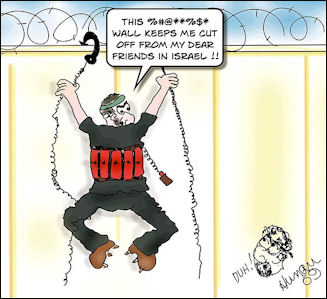
There were only five terrorist bombings in 2005 after the cease-fire in February The low number was credited to the cease-fire agreement and the building of the wall between Israel and the West Bank.
In February 2005, a bomber who blew himself up among a crowd waiting outside a popular seaside Tel Aviv nightclub, killing five Israelis and wounding dozens. The attack was widely condemned rather than praised by Palestinian militants because it broke the cease-fire. Hezbollah and Syria were blamed. The Tel Aviv attack occurred just before midnight and was unusually powerful for a suicide bomb and sent out thousands of pieces of shrapnel. One survivor told AP, “This is the second time for me.” She survived a suicide attack outside an army base in 2003. Another said, “I was just about to get into my car, which was parked outside the club...Body parts landed all over my car.”
In July 2005, a suicide bomber blew himself up near a shopping mall in Netanya in northern Israel, killing two women and himself. In October 2005, a suicide bomber blew himself up at a falafel stand in the town of Hadera, killing five Israelis. In December 2005, a suicide bomber blew himself up at a shopping mall in Netanya in northern Israel, killing five and wounding more than 30. Al Aqsa Martyr’s Brigade took credit. The mall was a favorite target because it is so close to the West Bank.
Image Sources: Wikimedia Commons, with many of the images from the Israeli Defense Forces
Text Sources: New York Times, Washington Post, Los Angeles Times, Times of London, The Guardian, National Geographic, The New Yorker, Time, Newsweek, Reuters, AP, AFP, Wall Street Journal, The Atlantic Monthly, The Economist, Global Viewpoint (Christian Science Monitor), Foreign Policy, Wikipedia, BBC, CNN, NBC News, Fox News and various books and other publications.
Last updated July 2012
